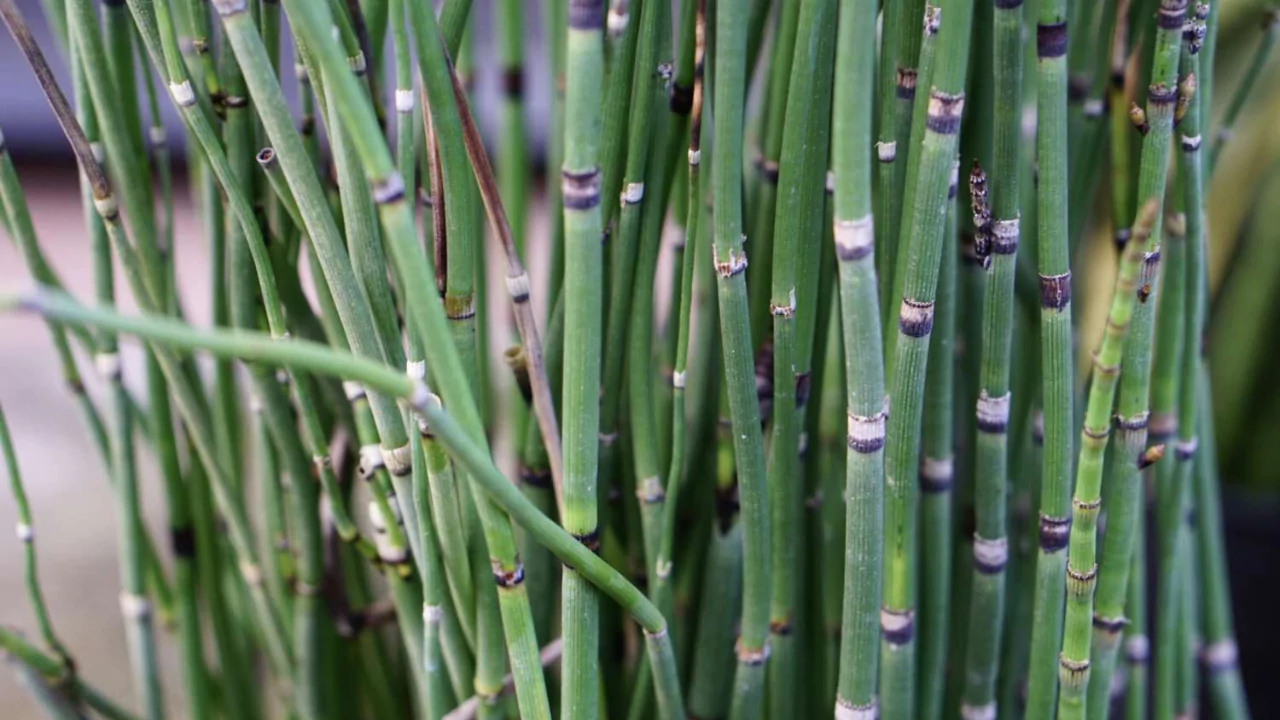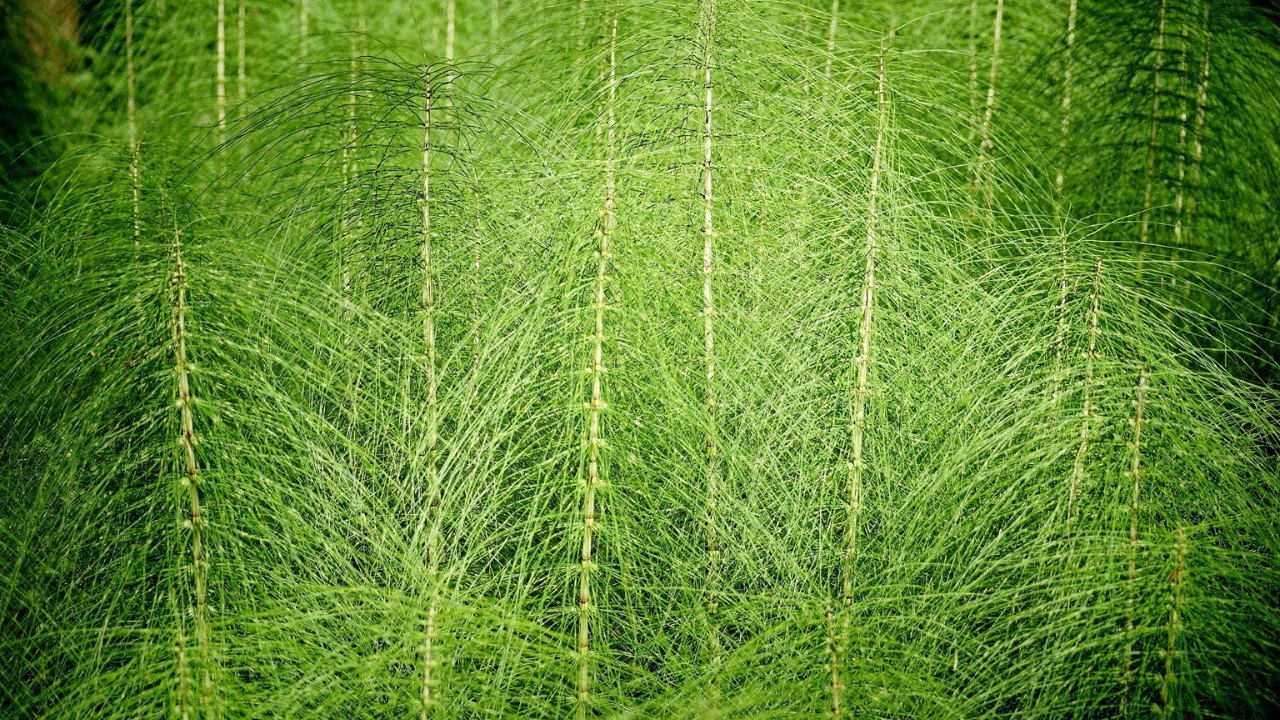
Removing horsetail plants (Equisetum hyemale and Equisetum arvense) from your garden is challenging, but not impossible. In this text, we’ll discuss two strategies you can try to manage this persistent plant.
| Horsetail Facts | |
| Botanical name | Equisetum |
| Common horsetail names | scouring rush, snake grass, or horse pipes |
| Plant type | Evergreen perennial |
| Flower Color | It is a non-flowering plant |
| Size when mature | 1-6 feet wide, 2-6 feet tall |
| Sunlight exposure | Does well in full sun or partial shade |
| Soil pH | 6.5 -7.5 |
| Soil type | Well draining soil that is moist |
| Native area | (Most of the northern hemisphere) Eurasia and North America |
| Hardiness Zones | 4-9 |
Gardeners who have experience with horsetails understand how this ancient plant has survived for close to 350 million years.
Today, horsetail, also known as ‘scouring rush’, is grown as a perennial in USDA zones 3 through 11. It is a fast-growing plant that can reach up to 4 feet tall and 6 feet wide.
Horsetail Equisetum arvense or Equisetum hyemale can function as:
- A modern-looking landscape accent plant.
- A disastrous plant that could be considered an invasive species as it is an aggressive plant that is extremely difficult to get rid of.
Horsetail can be quite a nuisance as it is very difficult to get rid of once it has taken over an area such as a garden or field. With this in mind, we will analyze the scouring rush from both viewpoints.
What is the Plant Horsetail Good For?
There are over 25 species of horsetail plant. This includes both annual and perennial varieties. Some species of scouring rush possess a vertical, grass-like form that resembles horse tails (hence the name). Others are fern or fan shaped.
Of horsetail reeds, Equisetum hyemale and Equisetum arvense are the two species that are cultivated in the landscape. These tall grass-reeds bear green straw like, segmented stems which are jointed like bamboo.
A horsetail reed has an exotic, tropical looking slender stem that is vertically elongated. Horsetail Equisetum arvense can add life to your garden. As depicted below, its aesthetic contribution is appreciated in the home landscape as well.

The elegant stems form a striking visual appeal, particularly when positioned en masse, and are stunning near ponds or water features. Additionally, they can act as groundcovers, vegetative screens, or even privacy screens.
The plants thrive in or near wet sites such as bog gardens, bushes, and worldwide wetlands. However, their use is not restricted to these environments. They can be placed in entranceways, used as container plants, or arranged in pots shaped like a border or small fence.
Between the pots, scouring rush can be interplanted with ornamental and variegated grasses to create contrast and an aesthetic effect. If proper landscape maintenance is followed, the various textures, sizes, and shapes can blend harmoniously.
To control unsightly spreading, the plant can be placed in a large container set on a concrete patio. This design restriction curbs the plant’s ability to spread disruptively while retaining modern elegance.

How Do You Get Rid of Horsetail in My Garden?
All types of horsetail plant flourish in nutrient deficient sandy or gravelly soils. Some species are quite tolerant of drought, while others require some moisture and water.
Because of its aggressive spreading, horsetail is often considered a weed. Knowing which horsetail species to keep in your garden is important:
- Equisetum hyemale has aesthetic qualities you might find pleasing.
- It’s Equisetum arvense to watch out for. It has a bushy look and grows to beeight inches tall, sometimes less. Its common name is field horsetail.
Horsetail is particularly unwelcome in livestock pastures. This is due to the fact that the stems are toxic to sheep and cattle.
Both spores and underground rhizomes are how horsetail plants propagate. They possess a broad-rooted system. Because of this, after cutting the scouring rush, it becomes a nuisance because it can easily regrow.
If you wish to eliminate horsetail, be ready to wage war and try one of the following methods.
Organic Method
Your only organic method of control is to cut all the stems back to ground level. At the beginning of spring, search for the spore-bearing stalks and cut them with gardening shears. Dispose of them in a plastic bag right away after you cut them.
While doing so, you can also improve the soil to make it drier, richer, and more alkaline.
Horsetail is fairly hardy and it might take multiple years to remove all the stems using this method. Don’t worry, you have another method.
Systemic Herbicide
Removal of Equisetum arvense or other common horsetail species can be done using a systemic herbicide.
You are to spray the horsetail Equisetum with a herbicide that contains triclopyr and is meant for horsetail plants.
Be sure to apply the herbicide on a calm day with no wind to avoid drift and herbicide damage to other plants in your garden. Be sure to follow the instructions on the label.
Start improving the soil after the horsetail (Equisetum) has died back. To improve the soil’s fertility, texture, and drainage, you can amend the soil with manure or compost. Planting the area with grass or perennials is another option.
Horsetail may not flourish in fertile soil. An option is to put down landscaping fabric and mulch over your garden, but this should only be done after removing all the spore-bearing stalks from your garden.
How Do You Take Care of a Horsetail Plant?
The problem with dealing with horsetails is managing their rapid spread. To manage the explosive growth of horsetail stems, make sure to prune the stems annually.
To cultivate horsetail, you can place plastic barriers in the soil or use a deep pot that can be buried into the ground.
Horsetail are not demanding plants. They do not require a rich or fertile soil. If your horsetail plant is struggling, you can provide it with slow-release plant food to aid its recovery.
High humidity paired with hot sun helps the plant grow best. You don’t need to worry about scouring rush in the winter, they can withstand drier air and less light. The only change that is noticeable is the dark green stems fading. This returns to normal as the weather shifts.
To get the most out of your horsetail plant, do the following:
- Plant horsetail reeds in part sun or full sun.
- Ensure the soil is somewhat acidic and not overly rich.
- Water the plants frequently to keep the soil consistently moist.
- Leave a space of about 12 inches between them if you want to install multiple.
If you have a rain garden and enjoy horsetails, go right ahead! These plants are adaptable and can survive both dry and wet conditions. They may thrive in bogs, along stream banks, or in water up to four inches deep.
What a nice way to accentuate your garden’s borders!
In addition to field horsetail, you can also cultivate giant horsetail or variegated horsetail.